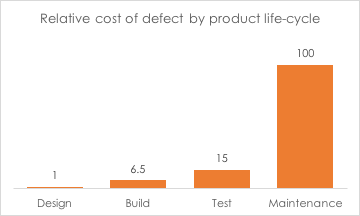As electronics and RF systems have become increasingly complex, the need to catch and fix errors during the design phase of a project has become increasingly important.
Catching an error during the design phase is orders of magnitude less expensive to fix than catching it during the manufacturing or test phases.

One of the best tools in an engineer's toolbox for catching design errors are design peer reviews at critical points in the development life cycle of our products.
5 simple steps to hold the most productive design review possible for your next project
1. Enlist independent reviewers
The goal of building out the review team should be to field a group that can challenge and push the design further. I had a colleague explain it to me like this: "when you only include people who are familiar with the design, you don't get the advantage of fresh perspective and ignorance. The most dangerous phrase during a design review is "this is how we always do it." The review team should be able to question and push on the design."
Asking your "work buddies" to review your work is an easy route, but it's not likely to produce the best designs. Even having a review team that is exclusively made up of people familiar with the project could lead to an echo chamber and group think.
For the best review, create an independent review team of multiple discipline engineers with varying levels of experience. It's important to have a fresh set of eyes and folks that will approach a problem from potentially different angles.
2. Stop the review if people are not prepared
One of the most memorable (and productive) design reviews of my career occurred a couple months after graduating and becoming an engineer. I was a junior engineer on the project and we were heading into CDR (critical design review). When the day came to review the circuit design my team had been working on tirelessly for months, we all gathered into the conference room waiting for the meeting to begin. A few minutes into the meeting, it became clear that a couple of our reviewers had not had a chance to fully review the technical content and design. Instead of bringing them up to speed, the chair of the design review (a senior engineer on the project) halted the meeting immediately, asked sternly why they had not completed their review prior to the meeting, and then quickly cancelled the remaining design review until they were able to complete their review.
This experience had a lasting impact on my understanding of how to conduct a successful review. The meeting itself is not a time to actually review the design. It is a time to come with your redlines, questions, concerns, and comments.
In order to hold the best possible review, ruthlessly insist that everyone comes prepared and ready to jump into the difficult tasks of improving the design.
3. Check your feelings and emotions at the door
If a design review is conducted properly, no design decision is left unquestioned. For an engineer, our designs are a part of our identity. Like an artist and their paintings or a composer and their music, our designs represent us as engineers. So it stands to reason, a meeting where you're surrounded by your peers while they question every aspect of your work can be difficult if you're not in the right frame of mind.
It's important for both the designer and the review team to avoid emotionally charged comments and attacks.
That being said, if you're passionate about your work like most of us, it's natural for the conversations to get a little heated. The important thing to remember is that we are all on the same team and we are all seeking the same thing, to get the best design possible with as few defects as possible. So check your feelings at the door, bring an open mind and be prepared to answer the hard questions.
4. Take notes in real time (digitally)
These days almost everything of importance ends up in digital form. Yet for many of us who are engineers, we still live and die by our paper engineering notebook. I'm not advocating against paper notebooks, I'm simply suggesting for this use case, taking notes digital will be faster, more complete, and will allow you to get actions assigned (and closed) more quickly.
If you are intimidated by taking effective meeting notes, you can use the follow-up email template below (Step 5) to help guide your note taking. If you have trouble running a review, taking notes, and discussing your design decisions, then ask a co-worker to be the scribe for the design review. This is a great task for engineering interns or recently minted engineers. It will take some of the pressure off your shoulders and help the junior engineer feel like they are contributing in an important way.
5. Follow up immediately
Now I know this may come as a surprise to most of us, but the majority of meetings are basically worthless. They could have just as well been an email and saved everyone invited precious time to be doing something more productive. Design reviews are one of those special exceptions that is actually worth pulling a bunch of high paid engineers into a room together.
There's a epic email salutation on this site I found recently that says "Do good, crush evil, but document it." Design reviews are certainly a place to do good. They are a great way to crush evil design defects. So it only stands to reason that we should document it.
The best way to document your next design review (and every single meeting you ever run) is with a short email that follows a simple format. It should include three pieces of information... a list of decisions made, a list of actions opened, and a quick description of what's coming next.
Here's a real example from a meeting we held last week.
|
From: Tommy R Decisions Made
Actions Open
Follow-up/Next meeting
|
Following these 5 simple steps will ensure you're conducting the best possible design review and will set you up for success in your career as an epic engineer!
We want to hear from you!
What other steps would you add for holding truly productive design reviews? Do you have any notable stories of design reviews gone right or wrong?







